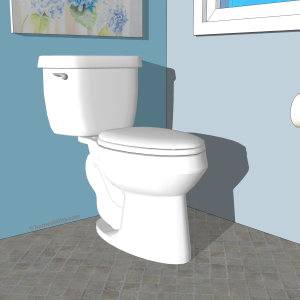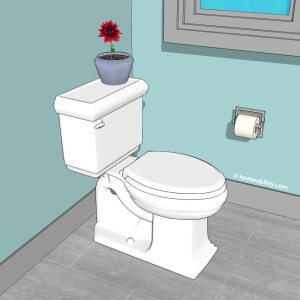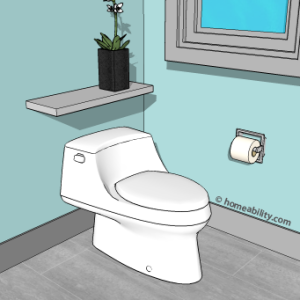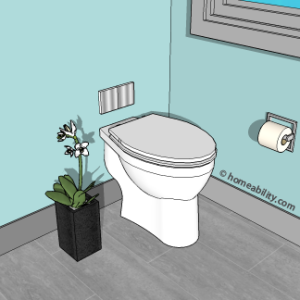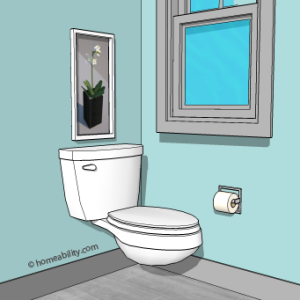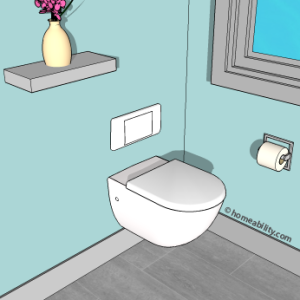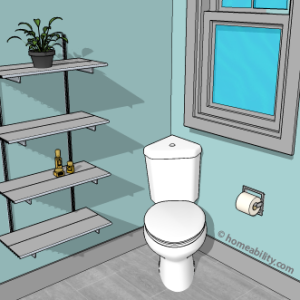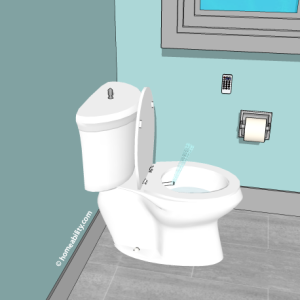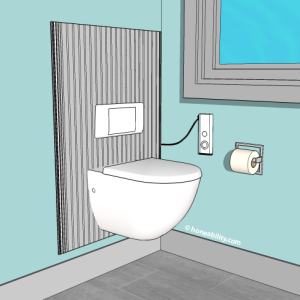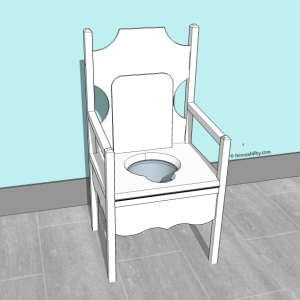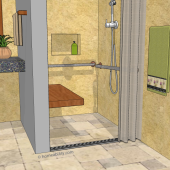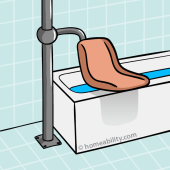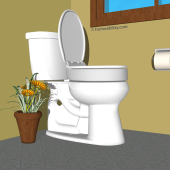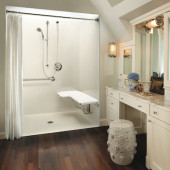Toilets for Disabled Person: Which type is Best?
The reasons to seek an accessible toilet can be many, so in short – one type of toilet will not work for everyone. The features that can make a toilet accessible for different people may include:
- higher-than-average toilet seat height
- compatibility with other toilet equipment/accessories
- small footprint (requires less floor space)
- bidet features
In order for you to determine which type of toilet is right for you, it’s helpful to first understand what your options are. Below you’ll find a quick overview of the different toilet types. Beside each we have identified some of the key elements that make each of them more (or less) easily accessible to aid you in determining which type will best match your own personal needs and the architectural features of your bathroom.
- Two Piece Toilet (aka close coupled toilet)
- One Piece Toilet
- Comfort Height Toilet (aka Chair Height Toilet, ADA Toilet)
- Easier for a tall person to sit down and stand up from the toilet.
- Easier for some (but not all) wheelchair users to slide sideways from the wheelchair seat to the toilet seat.
- Floor Standing Back-to-Wall Toilet
- Wall Hung Toilet Bowl and Tank (aka Off-The-Floor Fixtures)
- Wall Hung Toilet Bowl & Concealed Tank
- Corner Toilet
- Toilet Bidet Combination
- Motorized Adjustable Height Toilet
- Portable Toilet (aka Commode, Portable Potty)
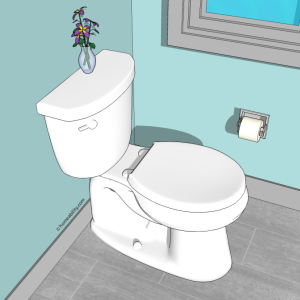 |
|
| Comfort Height Toilet | |
| What Is It? | A comfort-height toilet (aka ADA Height Toilet) is a toilet with a higher-than-average toilet seat height of 17-19 inches measured from the floor to the top of the seat. In contrast, most standard toilets have a seat height of 16″ or less. |
| Pros: |
|
| Con: | Persons who are shorter in stature tend to find these toilets to be uncomfortably high because they can cause their feet to dangle down, which in turn can cause their legs go numb while seated on the toilet. |
| Alert: | It is a common misconception to assume that an ADA height toilet is best for all persons with disabilities. It is not! If the toilet is being installed in someone’s private home, it is important to assess on a case-by-case basis whether a higher toilet seat height is truly appropriate or not. To learn more about picking the best toilet seat height, click here. |
Comfort Height Toilets Amazon.com
Floor Standing Back to Wall Toilet Amazon.com
Wall Mounted Toilet Bowl With Tank Amazon.com
Wall Mounted Toilets Amazon.com
Corner Toilets Amazon.com
Bidet Toilet Combo Amazon.com
Elegant Commodes Amazon.com
What should you keep in mind when choosing a new toilet?
- Floor Space
If your you use a walker or wheelchair and your bathroom is small, the smaller the toilet you select, the easier it will be for you to move around inside the bathroom. Wall mounted toilets and back-to-wall toilets with the tank installed inside the wall are both great options for maximizing usable floor space. The shape of the bowl selected can also a play a role in enhancing usable floor space. A toilet with a compact-sized toilet bowl (round or square) will typically occupy less floor space (often 2″ less) than models with elongated bowls. In small bathrooms, every inch counts! - Weight Capacity
If there are persons living in your household who have bariatric needs or you anticipate there will be guests visiting your home with bariatric needs, we recommend to confirm with the manufacture what the maximum weight limit is for the model selected prior to purchasing. The representatives we spoke to at American Standard and Kohler, reported that most of their floor mounted pedestal-style toilets can accomodate 1000 pounds of static, vertical force. The representative we spoke to at Toto reported that most of their floor mounted toilet models can accomodate somewhere between 400 lbs to 500 lbs of vertical force. In general, most wall-mounted toilet models, when installed correctly, will accomodate a weight capacity that falls in the realms of 350-500 lbs. A few wall-mounted toilet carrier system are specially designed to accomodate up to 1,000 pounds. - Toilet Height
When selecting an accessible toilet, many people immediately think “the higher the seat height the better”. This is not always true. The taller toilets, known as Comfort-Height Toilets, can be uncomfortably high for shorter adults, children, and some wheelchair users. Ideally, select a toilet model with a seat height that is high enough that you can easily transition on and off the toilet, yet low enough that you can comfortably rest your feet flat on the floor when you are seated on the toilet. To learn more about how to choose the best toilet height, click here. - Location & Type of Flush Controls
The toilet flusher comes permanently fixed to a specific part of the toilet, so it is important to take this feature into consideration prior to selecting a toilet model. Toilet flushers come in four different types, which include: a lever-style handle that is permanently fixed on the right or left front-side of the toilet tank; a button that is located on the top center of the toilet tank or wall behind the toilet; a pedal located at the base of the toilet that can be operated using a foot, or an automatic touch-less flusher operated via sensors that can be added to the toilet.Toilets & Touch-less Flusher Amazon.com
- Installation
Floor-mounted toilets are easiest to install. Any licensed plumber should be able to install a floor-mounted toilet correctly. If you have a wall-mounted toilet installed, select a professional who is experienced with installing this type of toilet to ensure the support structure is installed inside the wall correctly. - Ease of Cleaning
If you have difficulty bending and reaching low surfaces or hate the task of cleaning behind and around a standard floor-mounted toilet, a wall-mounted toilet is a good consideration. The lack of pedestal base makes it much easier to pass a mop underneath the bowl to clean the floor around the toilet. - Water Efficient
Selecting a watersense-labelled toilet (a toilet that meets certifications for using less water per flush) and/or a dual-flush toilet (one that allows you to select the amount of water used based on whether the toilet contents are solid or liquid) can help you to conserve water and save on monthly water bills.
Water Efficient Toilets Amazon.com
Average Cost to Install Floor & Wall Mounted Toilets
Standard, floor-mounted toilets will usually cost on average $200-$500 to purchase and have installed. A wall-hung toilet can cost on average $1,500-$2,000 to purchase and have installed. Wall-hung toilets cost more, because there are more parts to purchase and it takes more time to install the support frame inside the wall and/or to reinforce the existing walls.
A floor-mounted back-to-wall toilet with the tank concealed inside the wall is usually less expensive to install than the wall-mounted toilets because it does not require the same support structure. The back-to-wall toilets will be more expensive to install, however, than a standard toilet because the plumbing will need to be modified so the pipe in the floor lines up with the pipe located inside the toilet.
Prices will be lower than those shown here if you can install it yourself and may vary from those listed here, depending on the brand selected and your geographic region.
The Homeability Advice™ 
If you are designing a bathroom, with the intent being that it should be user-friendly for everyone who enters (immediate family, grandparents, friends who visit), one of the most important features to include is ample free, clear floor space. If space is at a premium inside the bathroom, the wall-hung style toilets with a concealed water tank are a great consideration. Since the tank resides inside the wall, an extra 9″-12″ or more of clear floor space becomes available in the bathroom, making it easier to move and turn around with a walker or wheelchair. The lack of pedestal base also makes it much easier to clean the bathroom floor around the toilet. (Yeah!)
Bidet-toilets and bidet-toilet seats are a great consideration for everyone! It does the washing – no wiping required. A toilet that’s enhanced with bidet features can be a particularly helpful addition for persons suffering from incontinence because it makes it much easier to stay fresh and clean. It can also be a great relief for persons with hemorrhoids. Some models (ones with a more powerful water stream) can be helpful for persons who suffer from constipation as well. If you are on a tight budget, replacing your existing toilet seat with a “bidet-style toilet seat” is a much more budget-friendly option than installing an entirely new toilet with bidet features integrated into the design.
Toilets on Amazon.com
Once you have determined the general type of toilet you feel will work best for you, then it will be necessary to narrow it down further to which manufacturer, make and model you like within the given categories. In future articles we will be exploring each of these categories in more detail, including the specific models and manufacturers. To stay up to date as new articles are added, sign up for the Homeability Newsletter.
More Topics You May Be Interested In
- “I can’t wipe myself!”: 6 Solutions to Make Toilet Hygiene Easier
- “I Can’t Get Up From the Toilet!” 10 Remedies
- Bidets: An Overview of the Basics
- Best Type of Toilet for a Wheelchair User
- Falls – Equipment to Help You Get Up Again

